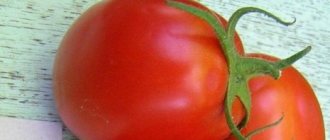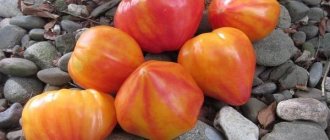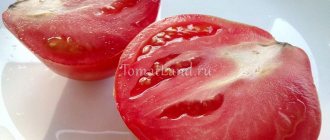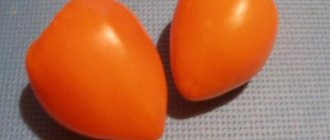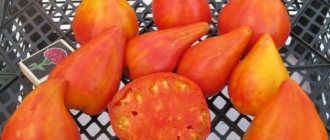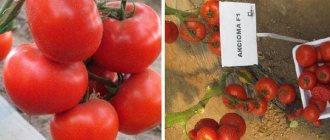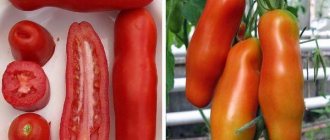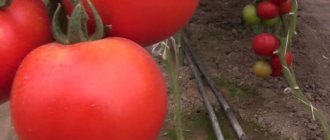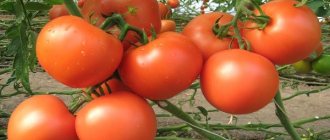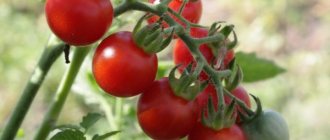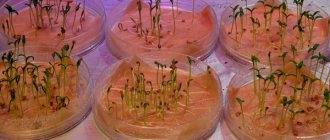It is quite possible to obtain massive yields in small areas if you plant indeterminates. The productive tall tomato hybrid Kirzhach F1 bears fruit abundantly in greenhouses and is characterized as a hardy and disease-resistant species.
| Height | Landing location | Ripening time | Fruit color | Fruit size | Origin | Fruit shape |
| Tall | Greenhouse | Mid-season | Reds | Large | Hybrid | Round |
Description of the tomato variety Kirzhach with photo
Tomato Kirzhach is a first generation hybrid (F1), obtained in Russia by a team of breeders (Volok, Morev, Gavrish, Amcheslavskaya). It has a very high yield - up to 6.5 kg per bush and relatively large tomatoes. Can be grown in greenhouses, in the south also in open ground. Included in the register of selection achievements in 2002.
Main characteristics of the Kirzhach tomato variety:
- indeterminate (grows without restrictions throughout the season);
- medium height (120-150 cm);
- mid-ripening (fruits begin to form in 108-120 days).
The bush is powerful, with strong shoots, heavily leafy. The leaves are green, typical shape, medium size. The flowers are light yellow, united in inflorescences of a simple type, the first of them is higher than 9, 10 or 11 leaves, and all subsequent ones are formed every 3. There are several ovaries on the raceme, which produce 5-8 Kirzhach tomatoes.
Description of fruits
Kirzhach tomatoes are bright red, pink, round in shape with flattened top and bottom. The surface is smooth, with slight ribbing closer to the stalk. The skin is strong, so the fruits are not prone to cracking. On average, the weight of tomatoes is 130-150 g (according to the register), often they reach 180-200 g, and the maximum registered weight is 500 g.
Tomatoes reach 6-8 cm or more in diameter. The pulp is very fleshy, juicy, has no voids, and has a pleasant consistency. The taste is classic, with a balance of sour and sweet shades, the aroma is pronounced. 3-4 seed chambers are visible on the cut. At the same time, it is not advisable to collect seeds, since the Kirzhach tomato is a hybrid, not a variety: newly planted bushes will not bear fruit.
1 brush can produce up to 8 Kirzhach tomatoes
Description of the variety
Tomato Kirzhach F1 is a first generation hybrid, the result of the work of breeders. This is an indeterminate variety characterized by an average ripening period (105-115 days). Tomatoes are grown in greenhouses. The tomato variety Kirzhach F1 fully meets the characteristics of indeterminate varieties: a tall plant, very leafy.
The stems are strong and not susceptible to breaking. The leaves are large and not very dissected. When growing tomatoes in a greenhouse, you usually pinch off the tops. The manufacturer recommends forming the tomato into one stem. The first inflorescence appears above leaves 9-11.
Tomatoes of the Kirzhach F1 variety ripen in large sizes and have a round shape. The peel is red, smooth and with a glossy sheen (as in the photo). The tomato is distinguished by its fleshy pulp and pleasant taste. Excellent for fresh consumption. The Kirzhach F1 variety is distinguished by its stable yield. On average, up to 6 kg of fruit can be collected from one bush.
Advantages of the indeterminate variety Kirzhach F1:
- long growing season. On the Kirzhach F1 tomato, new fruits are constantly formed, right up to the first autumn frosts;
- the tomato is resistant to blossom end rot, fusarium, and tobacco mosaic virus;
- there is a constant flow of air to the tied stems. Thanks to natural ventilation, Kirzhach tomatoes are practically free from late blight and rot;
- high yields in compact areas. Tomatoes are perfectly preserved and transported.
When growing Kirzhach, some disadvantages should be noted:
- the need to arrange trellises, which is associated with both material and physical costs;
- You cannot collect seeds of the Kirzhach F1 variety for growing tomatoes in the future. Which, in principle, is typical for all hybrids;
- A tomato of this variety needs constant care in terms of forming a bush, removing stepsons and excess foliage, and tying up stems. If you do not remove shoots, the greenhouse will turn into a continuous green thicket.
Characteristics of tomato Kirzhach
Tomatoes reach the stage of technical ripeness (typical size, green color) approximately 4 months after planting the seeds for seedlings. They can be left to ripen on the bush or sent to ripen in a dark, cool place. The yield of the harvest is uniform, with the main wave occurring in mid-July.
Kirzhach tomato yield and fruiting
The yield indicator is one of the main advantages of the Kirzhach tomato hybrid. If you grow them in a greenhouse, then from 1 bush you can get up to 6.5 kg of tomatoes over the entire season.
| Conditions | Greenhouse | Open ground |
| From 1 bush, kg | 6-6,5 | 4,5-5 |
| From 1 m2, kg* | 12-13 | 9-10 |
*Kirzhach tomato bushes are quite spreading, so the planting density is low: only 2 plants per 1 m2 (while 5 bushes can be planted per 2 m2).
To obtain the maximum number of tomatoes, it is recommended to grow the bushes in a greenhouse, and also follow the basic rules of agricultural technology:
- Regular watering and fertilizing.
- Ventilation of the greenhouse.
- Pinching (all side shoots are removed), pinching the top of the bush in early August.
- Forming a bush with 1 stem (if you grow it with 2 stems, the yield is often reduced).
- Tying to a support.
Area of application of fruits
Kirzhach tomatoes are universal in purpose. They are suitable for consumption immediately after ripening (fresh) and for preparing various dishes:
- sauces;
- soups;
- second courses;
- tomato juice;
- canned vegetables (lecho, adjika, squash caviar and other preparations).
These tomatoes are also suitable for whole-fruit canning - their skin does not crack even after long-term storage. But often the fruits are quite large - it is better to send them for processing or eat them fresh. You can try pickling it in a tub.
Resistance to diseases and pests
Hybrid Kirzhach has good immunity to common Solanaceae diseases:
- fusarium;
- cladosporiosis;
- late blight;
- tobacco mosaic.
Sometimes, if watering standards are not observed (excessive moisture), plants can suffer from rot. To eliminate the risk of infections, it is important to carry out preventive treatment with fungicides in May, before transplanting the seedlings into the greenhouse. In the event of an insect infestation, they can be killed with insecticides or homemade solutions.
Productivity
This variety is valued by summer residents primarily for the excellent taste of the fruit. The Kirzhach tomato has very good characteristics in terms of yield. Gardeners in a greenhouse often collect up to 6-6.5 kg of fruit from one such plant.
The undoubted advantage of Kirzhach, among other things, is that it is one of the earliest ripening indeterminate greenhouse varieties. The fruits of this tomato ripen already 110-115 days after planting.
You may be interested in: How to feed piglets? Rules for raising piglets at home and at a pig farm
The advantages of this tomato include the fact that its fruits ripen gradually. Therefore, summer residents have the opportunity to collect them until frost.
Advantages and disadvantages of the variety
Kirzhach tomatoes are one of the most productive varieties: even from 10 bushes you can collect 5-6 buckets of tomatoes: this amount will be quite enough for canning. In addition, the culture is unpretentious and resistant to diseases.
Kirzhach tomatoes have time to ripen on the branches
pros
- excellent yield;
- good taste of tomatoes;
- attractive appearance;
- good tying even in unfavorable weather;
- can be grown in any region (in a greenhouse);
- resistance to many diseases;
- good keeping quality and transportability.
Minuses
- bushes need to be shaped and pinched constantly;
- bushes must be tied up.
Tomato diseases
As already mentioned, Kirzhach is resistant to many tomato diseases. However, summer residents can still encounter various kinds of infections and fungi when growing these tomatoes in a greenhouse. The main threat to these tomatoes, like most others, is late blight and rot.
In order to prevent the development of such diseases, it is recommended to spray Kirzhach tomatoes with some fungicide for preventive purposes a couple of weeks after planting the seedlings. This could be, for example, Bordeaux mixture or simply a solution of copper sulfate.
Source
Features of cultivation
Since the Kirzhach tomato is a mid-season variety, seeds for seedlings begin to be grown in early March or even at the end of February (seedlings will grow at home for approximately 55-65 days). For growing them, universal soil or a mixture made independently from the surface layer of garden soil, humus and compost (ratio 2:1:1) is suitable. First, the soil must be kept in the freezer for 5-7 days or in the oven for 15 minutes at a temperature of 130 degrees.
Seeds are tested for germination in a 5% salt solution and those that float are discarded. They are also treated with a fungicide or 1% potassium permanganate. A few hours before planting, you can soak it in a stimulant solution - “Zircon”, “Kornevin”.
The growing technology is as follows:
- First, greenhouse conditions are created - under a film or glass lid, with humidification and lighting (the containers are placed in a warm place 25-27 degrees).
- After the sprouts appear, remove the lid and continue to moisten and illuminate.
- As soon as 3 true leaves are formed, Kirzhach tomato seedlings can be planted in glasses or pots.
- The temperature is lowered to 20-22 degrees, a week later complex fertilizer (in liquid form) is added.
- 12-15 days before transplantation, they begin to harden, gradually taking them out onto the balcony (temperature 15-16 degrees).
Kirzhach tomato seedlings can be grown even in ordinary plastic food containers
Kirzhach tomato seedlings are transferred to the greenhouse in early May, and to open ground in the middle of the month. Leave 60-70 cm between plants and rows; it is better to plant them in a checkerboard pattern. Agricultural cultivation technology includes several rules:
- Weekly watering (2 times more often during drought).
- Fertilizing 2 times a month - you can give complex mineral fertilizer in alternation with liquid organic matter (dung, mullein).
- Mulching the soil with peat, straw, sawdust.
- Loosening before each watering.
- Regular weeding.
- Ventilation of the greenhouse.
- Pinching and tying up a bush.
Kirzhach tomatoes are quite heavy, so the bushes must be tied to a support
Growing and care
The bushes are transplanted into the greenhouse if there are 7-8 leaves. The holes are placed at a distance of 45 cm. Add 1 tbsp to each hole. wood ash and superphosphate. A week later, the first garter is performed.
Formation is carried out in 1 trunk, pinching is required once every 7-10 days.
Fertilizer is applied 3 weeks after planting on the site. Before flowering, preference is given to nitrogen-containing products (nitroammophosphate, bioinfusions, mullein). During flowering and ripening, root feeding is carried out:
- Agricola;
- Kemiroy;
- Sturdy;
- Dobrivo;
- superphosphate.
For irrigation, boric acid and whey solution are used. Watering is carried out moderately, with a frequency of 1 time every 3-4 days. Use settled water. The best time is evening hours.
Pest and disease control
A week before transplanting the bushes into a greenhouse or open ground, it is recommended to treat them with a fungicide:
- Bordeaux mixture;
- "Maksim";
- "Ordan";
- "Topaz";
- "Skor."
Insects in the first stages of the invasion can be removed manually or washed off with medium pressure water. Then the Kirzhach tomato bushes are treated with a solution of baking soda, onion peels, garlic or insecticides:
- "Fitoverm";
- "Aktara";
- "Decis";
- "Fufanon";
- "Confidor".
Important! The treatment is carried out in the absence of rain and wind, preferably in the late evening. After applying chemicals, fruits cannot be removed for 5-10 days (the waiting period is indicated in the instructions for the product).
Tomato pests and diseases
Kirzhach is characterized by increased resistance to many diseases. However, in greenhouse conditions there is a possibility of the appearance of some diseases.
Late blight (fungal disease) is one of the most common diseases of tomatoes. High humidity in the greenhouse and cool temperature can provoke the appearance of fungus. The disease affects tomatoes, leaves, and stems. Symptoms appear as brown spots.
Kniphofia flower Planting and care in open ground Growing from seeds Photos of species and varieties
The complexity of the situation lies in the fact that it is no longer possible to completely cure the plant. Alternatively, you can contain or slow down the development of the disease in time to harvest the tomatoes. Therefore, the main way to fight is prevention, which will prevent the onset of the disease or slow down its development:
- the soil in the greenhouse before planting seedlings is treated with a biological solution (Gamair, Alirin) in the proportion: tablet per 10 liters of water;
- after planting the seedlings, Kirzhach F1 tomatoes are sprayed with solutions of biological preparations (Gamair, Alirin) at the rate of one tablet per liter of water;
- Sudden changes in air temperature (decrease) and humidity (increase) should not be allowed in the greenhouse. If signs of disease appear, you should immediately reduce the number of waterings.
Of the greenhouse pests of Kirzhach tomatoes, slugs are especially worth highlighting, as they can significantly reduce the tomato yield. You can get rid of pests in various ways: chemical, agrotechnical and mechanical.
Agrotechnical ones involve loosening and digging the soil, weeding and timely thinning of tomatoes.
Mechanical ones involve the use of traps (sheets of cardboard, pieces of burlap, boards). The devices are installed in the evening, and in the morning the pests are collected and destroyed. However, this method is considered ineffective, since after a short period of time the slugs appear again.
Chemical agents are considered more effective. Saturated salt solutions, a 10% solution of copper sulfate, a mixture of stove ash, mustard, and red pepper are used. Processing must be carried out repeatedly.
Thanks to its high yield and unpretentiousness, the Kirzhach F1 tomato is becoming increasingly popular among gardeners. And disease resistance allows it to be grown in different regions.
Description of tomato
The variety belongs to an indeterminate plant that bears large fruits with a natural taste. To describe the Kirzhach tomato variety, one can highlight the features of its stem, leaves, root system and fruits. They harmoniously form the overall structure of the plant.
The variety has high stems up to 1.5 m with good ovaries, on which inflorescences are located in an average number of 4 to 6 pieces. This stem is stable and can withstand large tomatoes as well as dense foliage. The shape of the leaves is elongated, rich green.
The Kirzhach tomato is characterized by a branched root system - a main root with many appendages that perform the nutritional function well
Description of fruits
Kirzhach tomatoes come in large and medium sizes from 150 to 250 g. They have a round shape divided into 5-7 segments. The juicy pulp is covered with a smooth, dense red skin with a glossy sheen, which protects the tomatoes well from cracking.
According to numerous reviews, Kirzhach F1 tomatoes have a natural taste and aroma, and they have a medium ripening period.
